If any conclusion has come for decades of research about snow avalanche survival, it’s that if you’re buried you’d better get dug out fast. Hence, carrying a snow shovel while backcountry skiing has become axiomatic. But what tool?

K2 Rescue Shovel is a well designed avalanche rescue tool. Which brings up lots of interesting issues...
Thing is, any sort of ISO or other standard has never been promulgated for the avalanche rescue shovels used for backcountry skiing, snowmobiling, and other snow sports. As a result, debate has ebbed and flowed as to the what size, strength and configuration makes the best shovel. On the one hand, we have the strength and beef advocates who pan many available shovels, and design brutal tests that only a few shovels can pass. Conversely, efficiency fans say so long as the shovel will last through one rescue and move lots of snow, “make it light so I’ll carry it!”
One such extreme test was carried out a few years ago by the Austrian Alpine Club. Known as the Genswein test, criteria included controversial standards such as providing a shovel top edge strong enough to be aggressively stomped into the snow by a ski boot. Valid criticism came up, such as the fact that when digging for a live victim using a shovel by driving it in with your foot is probably not a desirable nor necessary technique. Indeed, our take is that while the Genswein was a noble effort, it over reached and did a disservice to all of us as we feel shovel testing should be oriented much more towards digging speed and ergonomics of fresh slab avalanche debris, rather than imaginary abuse. (Incidentally, the urban myth of avalanche debris immediately setting up like cement is exactly that. I’ve observed and tested in the field. Sure, avalanche deposition does eventually solidify, sometime to almost the consistency of ice, but fresh debris other than those from a wet slab avalanche usually remain fairly easy (but time consuming) to dig for the “life window” time you have to dig out a live victim. More, it could be argued that in the case of deep burial in timbered terrain, a wood saw to remove trees and branches might be of significantly more importance than how strong your shovel is.)
At any rate, due to the lack of any other meaningful standard or organized testing, making a shovel that holds up to the Genswein criteria has become a defacto standard for some shovel makers who market for backcountry skiing. Our take: If a shovel can be made that strong and not too heavy, that’s probably fine, though we wonder if we’ll be carrying around five or six extra ounces of unnecessary weight no thanks to Genswein and associates.
Enter the K2 Rescue Shovel. Upfront, let me say that K2 appears to have achieved a design that would hold up to the Genswein abuse, while still being reasonable in size, weight, and pack-ability. At 25.7 ounces (without internally stored rescue sled kit) the Rescue could perhaps be a few ounces lighter, but hail those of you who feel most shovels are too weak — here is one you’ll quit whining about. More, it’s got some excellent features.
Beyond knowing it’ll last virtually forever in normal backcountry use, we find numerous “likes” regarding this tool. First, it packs easy by virtue of minimal blade curvature (and also works nicely for shovel shear tests and so forth). Avalanche snow shovels don’t need radically curved blades, so good job K2 on that one. Next, The “+” model has a sweet little hardware kit stored in the shaft that helps you build a rescue sled out of your skis. Optional configuration as a snow hoe and a nice long two-section shaft round out the positives. Aside from the weight, the only other con we came up with is that the grip, while good for right handers, is not ergonomic for left handers and is not reversible in orientation. Photos showing it all:
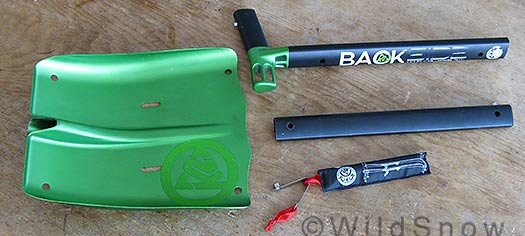
All the parts, sled kit is visible coming out of the lower shaft in photo. One thing you notice with this shovel is how thick the shaft walls are. That combined with an ovalized shape not doubt makes it super strong.
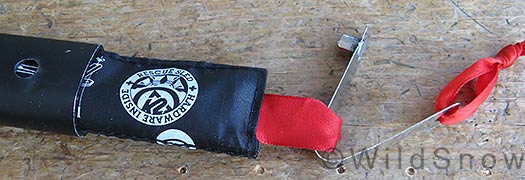
Sled parts kit is located in the handle, pulled out with red webbing tab.
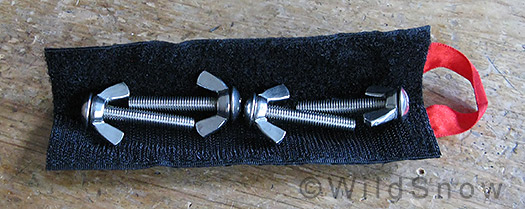
What you get for sled building is simple, just wingnuts and bolts that attached shovel shaft and blade to the skis. We'll review sled construction in the future.
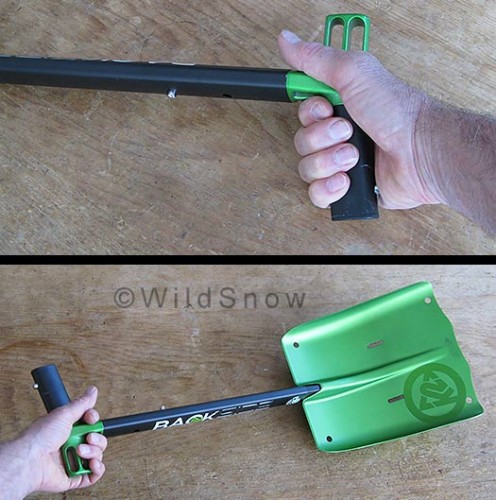
Grip ergonomics. Upper photo is normal right-handed grip, lower shows left handed grip.
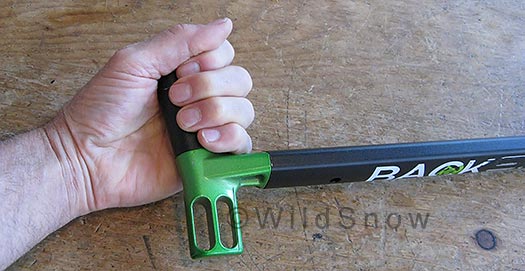
Another way you can grip left handed. Works, but not as ergonomic as right handed.
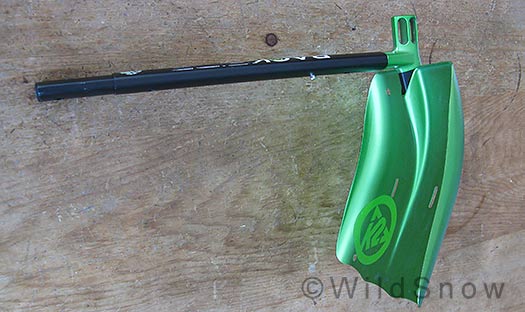
Latest studies in how to quickly dig out an avalanche victim conclude that snow must be move laterally, as efficiently as possible. Dragging the snow with a hoe-like shovel configuration can be the ticket. K2 Rescue shovel converts to hoe, but without a grip the shaft probably needs some friction material rather than slick powder coating. Owner added gription tape would suffice.
Conclusion, the K2 Rescue Shovel is a top choice for guides and professionals who need long-term durability for constant use. Other users will do fine with this shovel as well, but could perhaps save a few ounces weight by using a slightly less durable yet adequate shovel. The shaft-stored rescue sled parts are a nice touch. In all, good to see constant effort in making better backcountry skiing shovels, WildSnow.com thumbs up.
Estimated retail availability, October 2011.
WildSnow.com publisher emeritus and founder Lou (Louis Dawson) has a 50+ years career in climbing, backcountry skiing and ski mountaineering. He was the first person in history to ski down all 54 Colorado 14,000-foot peaks, has authored numerous books about about backcountry skiing, and has skied from the summit of Denali in Alaska, North America’s highest mountain.

